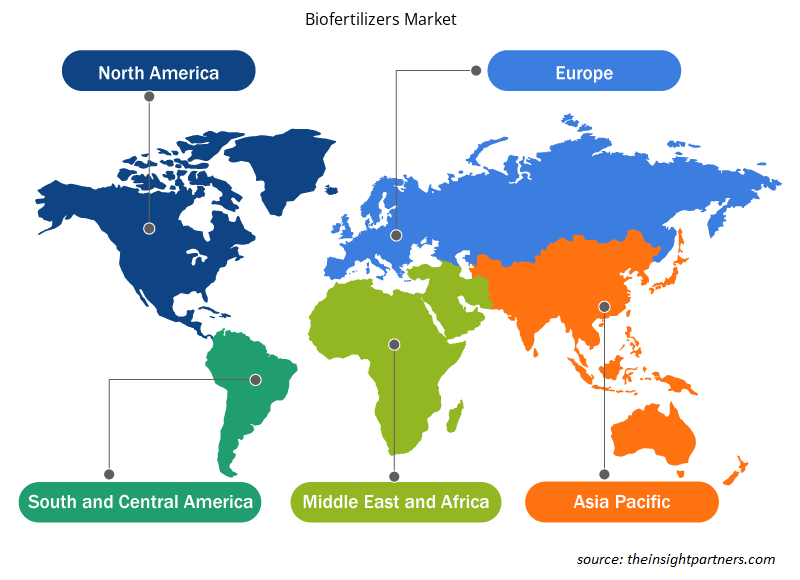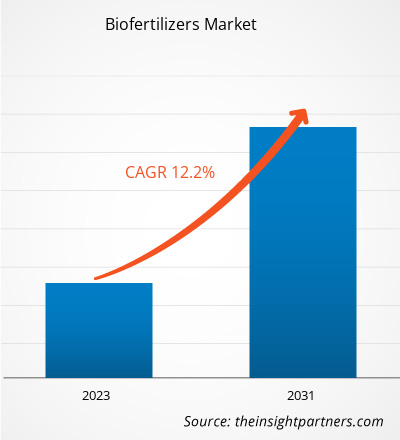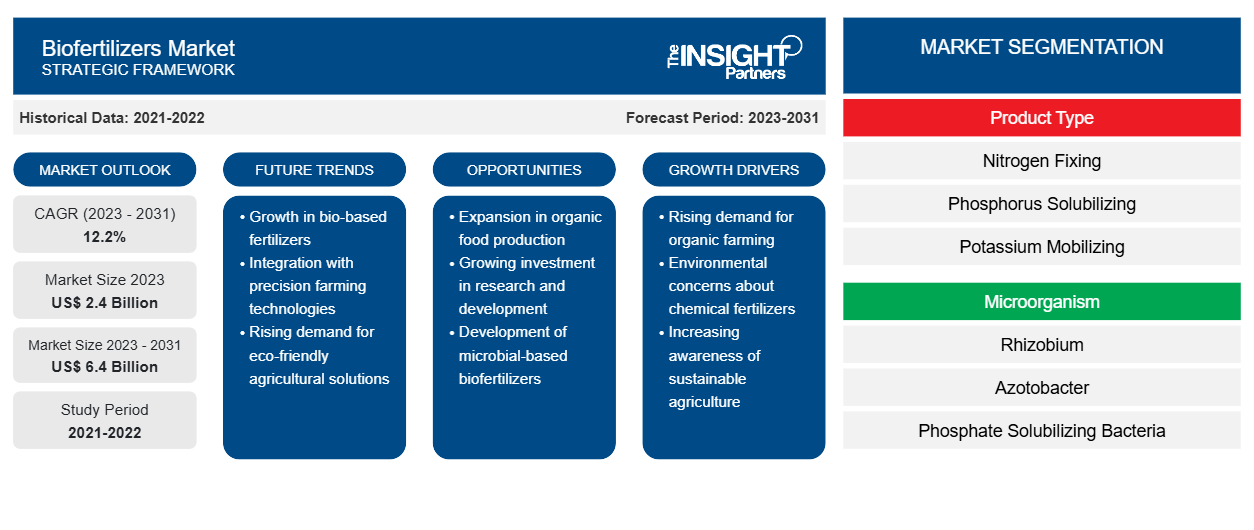من المتوقع أن يصل حجم سوق الأسمدة الحيوية إلى 6.4 مليار دولار أمريكي بحلول عام 2031 من 2.4 مليار دولار أمريكي في عام 2023. ومن المتوقع أن يسجل السوق معدل نمو سنوي مركب بنسبة 12.2٪ خلال الفترة 2023-2031. ومن المرجح أن يظل التركيز المتزايد لشركات التصنيع على الابتكار وتوفير منتجات جديدة لتعزيز تجربة العملاء من الاتجاهات الرئيسية في سوق الأسمدة الحيوية.
تحليل سوق الأسمدة الحيوية
تتضمن طريقة الزراعة العضوية نمو المحاصيل ورعايتها باستخدام المواد البيولوجية من خلال القضاء على استخدام الأسمدة الاصطناعية. يتم اعتماد الزراعة العضوية بشكل متزايد لتحقيق منتجات غذائية صحية وعالية الجودة . إلى جانب ذلك، توفر الزراعة العضوية العديد من الفوائد البيئية؛ على سبيل المثال، تعمل على تحسين خصوبة التربة، وتساعد في مكافحة تآكل التربة، وتقلل من انبعاثات الغازات المسببة للاحتباس الحراري. الأسمدة الحيوية هي أحد المكونات الأساسية لممارسات الزراعة العضوية لأنها تجمع بين الكائنات الحية الدقيقة الطبيعية والأسمدة الغنية بالمغذيات المشتقة عضويًا والتي توفر بيئة نمو صحية للنباتات والتربة. تساعد الأسمدة الحيوية أيضًا في تعزيز مقاومة النبات للآفات والضغوطات غير الحيوية مثل الجفاف والمياه الزائدة والتغيرات الشديدة في درجات الحرارة. وبالتالي، فإن النمو السريع في الزراعة العضوية بسبب زيادة اعتماد المنتجات العضوية من قبل المستهلكين في جميع أنحاء العالم يدفع نمو سوق الأسمدة الحيوية.
نظرة عامة على سوق الأسمدة الحيوية
تتكون الأسمدة الحيوية من الميكروبات والبكتيريا الحية التي تعزز خصوبة التربة ونمو النباتات. تدعم هذه الميكروبات عملية تثبيت النيتروجين لإنتاج المكونات الأساسية لنمو النبات. تشتهر الأسمدة الحيوية بفعاليتها من حيث التكلفة وطبيعتها الصديقة للبيئة. يشهد سوق الأسمدة الحيوية طلبًا مرتفعًا بسبب التحول في الاتجاه نحو الزراعة المستدامة . أدى الاهتمام المتزايد والدعم الحكومي للزراعة العضوية إلى ازدهار صناعة الأسمدة الحيوية. وبالتالي، من المتوقع أن يعزز سوق الأسمدة الحيوية نموه خلال فترة التنبؤ.
قم بتخصيص هذا التقرير ليناسب متطلباتك
ستحصل على تخصيص لأي تقرير - مجانًا - بما في ذلك أجزاء من هذا التقرير، أو تحليل على مستوى الدولة، وحزمة بيانات Excel، بالإضافة إلى الاستفادة من العروض والخصومات الرائعة للشركات الناشئة والجامعات
-
احصل على أهم اتجاهات السوق الرئيسية لهذا التقرير.ستتضمن هذه العينة المجانية تحليلاً للبيانات، بدءًا من اتجاهات السوق وحتى التقديرات والتوقعات.
محركات وفرص سوق الأسمدة الحيوية
مبادرات حكومية متزايدة وزيادة الوعي فيما يتعلق بتقنيات الزراعة المستدامة
تتخذ حكومات بلدان مختلفة مبادرات لدفع تبني الأسمدة الحيوية. على سبيل المثال، في الهند، تدعم حكومات الولايات المختلفة استخدام الأسمدة الحيوية بدلاً من الأسمدة الكيماوية أو الاصطناعية من خلال برامج أو مخططات مثل "Paramparagat Krishi Vikas Yojana (PKVY)" و"Mission Organic Value Chain Development for Northeastern Region (MOVCDNER)." وعلاوة على ذلك، تهدف "السياسة الزراعية المشتركة" التي وضعها الاتحاد الأوروبي إلى تعزيز استخدام الموارد البيولوجية في جميع أنحاء المنطقة. وبالتالي، فإن المبادرات الحكومية، جنبًا إلى جنب مع الميل المتزايد نحو الاستدامة في الزراعة الحديثة، تعمل على تحفيز الطلب على الأسمدة الحيوية في جميع أنحاء العالم.
زيادة إنتاج المحاصيل وعائداتها
يعد استخدام الأسمدة الحيوية أحد التقنيات المحتملة لأنظمة الزراعة المستدامة. يستخدم المزارعون على نطاق واسع الأسمدة الحيوية المذيبة للفوسفات المثبتة للنيتروجين لإنتاج المحاصيل ذات الطلب المرتفع مثل القمح والبذور الزيتية والأرز. وبالتالي، يتم تضمين كائنات دقيقة مختلفة في الأسمدة الحيوية للمساعدة في زيادة إنتاج المحاصيل وعائدها، وبالتالي توفير فرص نمو مختلفة لسوق الأسمدة الحيوية في جميع أنحاء العالم.
تقرير تحليل تجزئة سوق الأسمدة الحيوية
إن القطاعات الرئيسية التي ساهمت في اشتقاق تحليل سوق الأسمدة الحيوية هي نوع المنتج، والكائنات الحية الدقيقة، ونوع المحصول، والتطبيق.
- بناءً على نوع المنتج، ينقسم سوق الأسمدة الحيوية إلى الأسمدة المثبتة للنيتروجين، والأسمدة المذيبة للفوسفور، والأسمدة المحفزة للبوتاسيوم، وغيرها. احتلت شريحة الأسمدة المثبتة للنيتروجين أكبر حصة في السوق في عام 2023.
- بحسب الكائنات الحية الدقيقة، يتم تقسيم السوق إلى بكتيريا الريزوبيوم، والآزوتوباكتر، والبكتيريا المذيبة للفوسفات، وغيرها. احتلت شريحة الريزوبيوم الحصة الأكبر من السوق في عام 2023.
- من حيث نوع المحاصيل، ينقسم السوق إلى الحبوب والبذور الزيتية والبقوليات والفواكه والخضروات وغيرها. يهيمن قطاع الحبوب والحبوب على السوق في عام 2023.
- من حيث التطبيق، يتم تقسيم السوق إلى معالجة البذور ومعالجة التربة وغيرها. سيطر قطاع معالجة البذور على السوق في عام 2023.
تحليل حصة سوق الأسمدة الحيوية حسب المنطقة الجغرافية
ينقسم النطاق الجغرافي لتقرير سوق الأسمدة الحيوية بشكل أساسي إلى خمس مناطق: أمريكا الشمالية، ومنطقة آسيا والمحيط الهادئ، وأوروبا، والشرق الأوسط وأفريقيا، وأمريكا الجنوبية/أمريكا الجنوبية والوسطى.
لقد سيطرت أمريكا الشمالية على سوق الأسمدة الحيوية. وتعد أمريكا الشمالية واحدة من المناطق البارزة في سوق الأسمدة الحيوية بسبب الاستهلاك المتزايد للأغذية العضوية والخالية من المواد الكيميائية في جميع أنحاء المنطقة. وعلاوة على ذلك، تعد الولايات المتحدة من بين المنتجين الرئيسيين للأسمدة الحيوية في جميع أنحاء العالم؛ وعلى الرغم من أن الأسمدة الكيماوية لا يتم تصنيفها عادةً على أنها "صحية"، إلا أن المستهلكين يبحثون عن بدائل أكثر صحة مثل الأسمدة الحيوية. ووفقًا لوزارة الطاقة ووزارة الزراعة الأمريكية، فإن أحد محركات السوق هو العرض الوفير من المواد الخام للكتلة الحيوية. وهذه بعض العوامل التي تعزز الطلب على الأسمدة الحيوية في دول أمريكا الشمالية. ومن المتوقع أن تنمو منطقة آسيا والمحيط الهادئ بأعلى معدل نمو سنوي مركب في السنوات القادمة.
رؤى إقليمية حول سوق الأسمدة الحيوية
لقد قام المحللون في Insight Partners بشرح الاتجاهات والعوامل الإقليمية المؤثرة على سوق الأسمدة الحيوية طوال فترة التوقعات بشكل شامل. يناقش هذا القسم أيضًا قطاعات سوق الأسمدة الحيوية والجغرافيا في جميع أنحاء أمريكا الشمالية وأوروبا ومنطقة آسيا والمحيط الهادئ والشرق الأوسط وأفريقيا وأمريكا الجنوبية والوسطى.

- احصل على البيانات الإقليمية المحددة لسوق الأسمدة الحيوية
نطاق تقرير سوق الأسمدة الحيوية
| سمة التقرير | تفاصيل |
|---|---|
| حجم السوق في عام 2023 | 2.4 مليار دولار أمريكي |
| حجم السوق بحلول عام 2031 | 6.4 مليار دولار أمريكي |
| معدل النمو السنوي المركب العالمي (2023 - 2031) | 12.2% |
| البيانات التاريخية | 2021-2022 |
| فترة التنبؤ | 2023-2031 |
| القطاعات المغطاة |
حسب نوع المنتج
|
| المناطق والدول المغطاة |
أمريكا الشمالية
|
| قادة السوق وملفات تعريف الشركات الرئيسية |
|
كثافة اللاعبين في سوق الأسمدة الحيوية: فهم تأثيرها على ديناميكيات الأعمال
يشهد سوق الأسمدة الحيوية نموًا سريعًا، مدفوعًا بالطلب المتزايد من المستخدم النهائي بسبب عوامل مثل تفضيلات المستهلكين المتطورة والتقدم التكنولوجي والوعي المتزايد بفوائد المنتج. ومع ارتفاع الطلب، تعمل الشركات على توسيع عروضها والابتكار لتلبية احتياجات المستهلكين والاستفادة من الاتجاهات الناشئة، مما يؤدي إلى زيادة نمو السوق.
تشير كثافة اللاعبين في السوق إلى توزيع الشركات أو المؤسسات العاملة في سوق أو صناعة معينة. وهي تشير إلى عدد المنافسين (اللاعبين في السوق) الموجودين في مساحة سوق معينة نسبة إلى حجمها أو قيمتها السوقية الإجمالية.
الشركات الرئيسية العاملة في سوق الأسمدة الحيوية هي:
- الحياة الزراعية
- شركة بيوتك الدولية المحدودة
- مجموعة منتجات كيوا بايو تيك
- شركة مابلتون أجري بيوتيك المحدودة
- نوفوزيمز
- ريزوباكتر
إخلاء المسؤولية : الشركات المذكورة أعلاه ليست مرتبة بأي ترتيب معين.

- احصل على نظرة عامة على أهم اللاعبين الرئيسيين في سوق الأسمدة الحيوية
أخبار سوق الأسمدة الحيوية والتطورات الأخيرة
يتم تقييم سوق الأسمدة الحيوية من خلال جمع البيانات النوعية والكمية بعد البحث الأولي والثانوي، والتي تتضمن منشورات الشركات المهمة وبيانات الجمعيات وقواعد البيانات. فيما يلي قائمة بالتطورات في سوق اضطرابات الكلام واللغة:
- أعلنت شركة سينجينتا بيولوجيكالز وشركة يونيوم بيوساينس عن تعاونهما لتوفير حلول معالجة البذور البيولوجية المبتكرة القائمة على NUELLO® iN للمزارعين في جميع أنحاء شمال غرب أوروبا. (المصدر: سينجينتا، النشرة الإخبارية، 2023)
- قدمت Performance Nutrition علامتها التجارية NutriWise، وهي عبارة عن سماد حبيبي ومسحوق قابل للذوبان في الماء سيحل محل خط منتجات NutriSmart القديم. المنتجات الجديدة متاحة للأسواق الزراعية والعشبية والزينة. (المصدر: LidoChem, Inc.، بيان صحفي، 2022)
تقرير سوق الأسمدة الحيوية والتغطية والنتائج المتوقعة
يوفر تقرير "حجم سوق الأسمدة الحيوية والتوقعات (2021-2031)" تحليلاً مفصلاً للسوق يغطي المجالات التالية:
- حجم السوق والتوقعات على المستويات العالمية والإقليمية والوطنية لجميع قطاعات السوق الرئيسية التي يغطيها النطاق
- ديناميكيات السوق مثل المحركات والقيود والفرص الرئيسية
- الاتجاهات المستقبلية الرئيسية
- تحليل مفصل لقوى PEST/Porter الخمس وSWOT
- تحليل السوق العالمي والإقليمي الذي يغطي اتجاهات السوق الرئيسية واللاعبين الرئيسيين واللوائح والتطورات الأخيرة في السوق
- تحليل المشهد الصناعي والمنافسة الذي يغطي تركيز السوق، وتحليل خريطة الحرارة، واللاعبين البارزين، والتطورات الأخيرة
- ملفات تعريف الشركة التفصيلية
- التحليل التاريخي (سنتان)، سنة الأساس، التوقعات (7 سنوات) مع معدل النمو السنوي المركب
- تحليل PEST و SWOT
- حجم السوق والقيمة / الحجم - عالمي، إقليمي، بلد
- الصناعة والمنافسة
- مجموعة بيانات إكسل
التقارير الحديثة
تقارير ذات صلة
شهادات العملاء
سبب الشراء
- اتخاذ قرارات مدروسة
- فهم ديناميكيات السوق
- تحليل المنافسة
- رؤى العملاء
- توقعات السوق
- تخفيف المخاطر
- التخطيط الاستراتيجي
- مبررات الاستثمار
- تحديد الأسواق الناشئة
- تحسين استراتيجيات التسويق
- تعزيز الكفاءة التشغيلية
- مواكبة التوجهات التنظيمية























 احصل على عينة مجانية ل - سوق الأسمدة الحيوية
احصل على عينة مجانية ل - سوق الأسمدة الحيوية